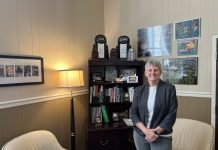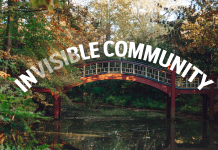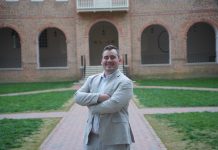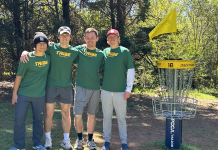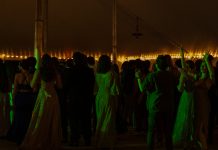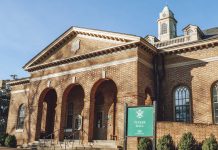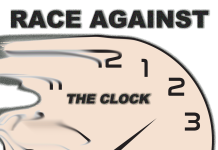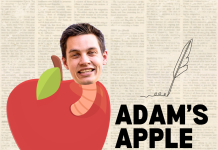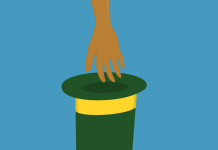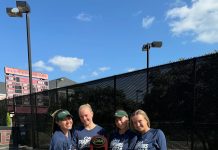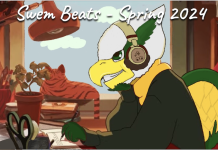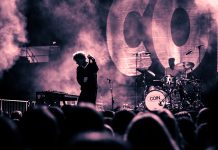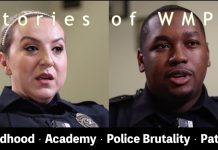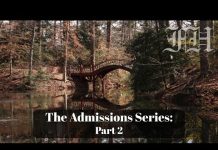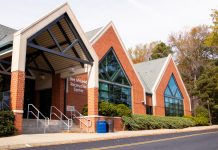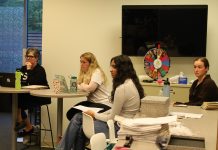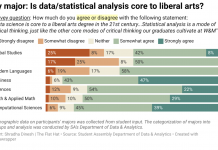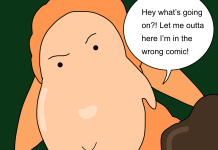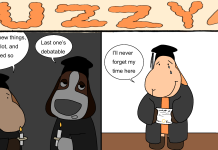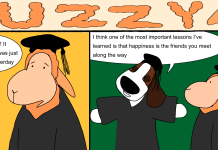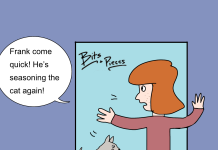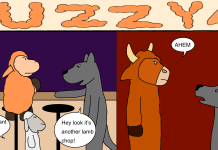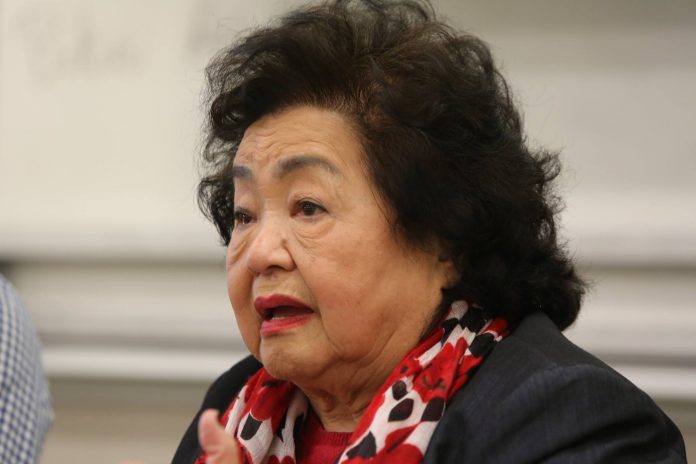
Wednesday, April 10, students attended a COLL 300 lecture given by Setsuko Thurlow, who survived the atomic bomb dropped on Hiroshima in 1945 by the United States. From her unique perspective as a survivor, Thurlow discussed the topics of peace and advocacy for complete nuclear disarmament.
Having been extended an invitation by professor Michael Cronin, the program director for Japanese studies at the College of William and Mary, Thurlow came to talk about how ceremony affects her as a hibukusha — a survivor of the World War II atomic bombs.
“One of the most important ceremonies in Japanese society is the ceremony every August 6 to commemorate or to mark the dropping of the atom bomb on the city of Hiroshima,” Cronin said. “I thought of Setsuko who has participated in that ceremony as a hibakusha, or survivor. It’s a unique role in Japanese society that comes with a responsibility to share testimony of that day.”
As a 13 year old who was in middle school during World War II, Thurlow was thrust into a life-or-death situation where students were enlisted to aid in the Japanese imperial war effort.
“I was a 13 year old grade eight student; in those days, Japan was losing badly, and we hardly had regular classroom work,” Thurlow said. “We were mobilized by the army to go to the factories to pack cigarettes to send to the front lines.”
“I was a 13 year old grade eight student; in those days, Japan was losing badly, and we hardly had regular classroom work,” Thurlow said. “We were mobilized by the army to go to the factories to pack cigarettes to send to the front lines.”
On the first day of her service to her country, Thurlow was lucky in that she was among a select group of schoolgirls chosen to be a decoder for the empire, which required her to travel to an army headquarters for work.
“That day, August 6, 1945, I was at the army headquarters because I was selected to be part of a group of 30 girls who had to learn how to decode top secrets,” Thurlow said. “We learned it quickly and on that very day, it was our first day to work as decoders. I was one mile from the hypocenter.”
Thurlow recalled that the army commander told her and her schoolmates the ultimate objective of their work was to demonstrate patriotism and loyalty to the emperor.
The exact moment that the atomic bomb was dropped on Hiroshima, Thurlow recalled seeing a flash while hearing the cries of her classmates. She also recalls being helped out of the building by a stranger.
“At that moment, I saw a blue-white flash,” Thurlow said. “Then, my body started flying up in the air, and when I regained my consciousness, I laid in total darkness and silence and I could not move. I knew that I had faced death. I heard whispering voices of my school mates. ‘Mother, help me. God help me.’”
Following her escape, Thurlow was taken aback by the horrors and atrocities that she witnessed outside the building. People affected by the blast had been horribly disfigured, and their last moments of living were horribly painful.
“About 30 girls who were with me in the same room were burned to death alive,” Thurlow said. “As I stepped out, I saw the outside world. Though it was morning, it was dark like twilight. As my eyes got used to the darkness, I started seeing movements. I saw human beings approaching me, but I couldn’t recognize them as such. Their hair stood and parts of their bodies were missing. Skin and flesh hung from their arms. Some carried their eyeballs, and one by one they collapsed to the ground.”
Thurlow pointed out that it was not just the people from Hiroshima who were impacted by the atomic bomb. Those who lived in nearby communities fell victim to radiation poisoning when they tried to help survivors from the fallout. The issue was exacerbated by the fact that doctors had not yet become accustomed to treating people with radiation poisoning.
“Living in the aftermath was phenomenally difficult,” Thurlow said. “People from neighbouring communities would also be contaminated by the radiation as thus became victimized. Doctors didn’t know how to deal with radiation poisoning yet — they didn’t have any knowledge.”
As a side effect, women who were pregnant during the blast passed along unintended health effects to their unborn children, whose development would be suddenly halted as a result of the radiation.
“Some women produced deformed babies,” Thurlow said. “We were of course under American occupation, so we don’t know exactly how many, but there are many pictures. Many of these babies had the condition known as microcephaly.”
During her time under American occupation, Thurlow witnessed the negative treatment that hibakushas suffered under rule from the American military.
“General McArthur came to demilitarize and to democratize Japan, but as far as Hiroshima and Nagasaki were concerned, he did the complete opposite,” Thurlow said. “Anything disadvantageous to U.S. forces was forbidden to be published in the papers. They confiscated the diaries and correspondence of survivors. Even haikus and photographs were taken and shipped back to the United States.”
Despite the censorship that she experienced as a hibakusha, she felt it was imperative to share her story as one of the few people with firsthand knowledge of nuclear war’s extensive human costs.
“The best contribution I could make to the word was to share information about what I experienced, what I saw,” Thurlow said. “The world knew about the atomic bomb, but they didn’t know what they did, how they destroyed. I’m not a physicist, but I do remember what I experienced and that’s something that no human being should ever experience.”
“The best contribution I could make to the word was to share information about what I experienced, what I saw,” Thurlow said. “The world knew about the atomic bomb, but they didn’t know what they did, how they destroyed. I’m not a physicist, but I do remember what I experienced and that’s something that no human being should ever experience.”
After moving to North America in the years following Hiroshima, Thurlow expressed her dismay at encountering Americans and Canadians who felt that the Japanese people deserved to have experienced the detonation of two atom bombs.
“In the United States, people were busy justifying the atomic bomb — that the Japanese deserved it — which is extremely painful for me,” Thurlow said. “Even in Canada, that kind of talk was prevalent.”
In closing her talk, Thurlow expressed condemnation against former President Truman’s actions, standing firmly in her belief that there is no circumstance whatsoever in which nuclear detonation on civilian populations is acceptable.
“It was not necessary, and Mr. Truman knew that,” Thurlow said. “People were starving in the streets, planes and ships had been destroyed by American forces. The Japanese government was not functioning, and the United States knew that. Hiroshima was an indiscriminate mass murder of innocent civilians, children, women and elderly.”
Due to her efforts with the International Campaign to Abolish Nuclear Weapons, Thurlow received the Nobel Peace Prize on behalf of the organization. Despite her successes in advocating for peace, she recalled a testing time in the 1980s when she was denied entry into the United States under the auspices of the McCarran-Walter Act, which was a piece of legislation passed during the rampant influence of McCarthyism.
“In August 1982, one million peace activists gathered together in Manhattan and marched to Central Park,” Thurlow said. “But, before I went, I was leaving Toronto and an American immigration official and looked at my passport and denied me entry, stating that the country had no need for additional ‘peaceniks.’ He never came back with my passport and made me miss my flight.”
Despite the setbacks in her past professional career, Thurlow is optimistic for the younger generations. Having worked with the United Nations, she sees the political involvement of youth as crucial, and feels hopeful that Canadian and American youth will be just as involved in the future.
“Spending time with high school students is the most gratifying thing,” Thurlow said. “I’ve received hundreds of letters from students. It’s a good thing teachers are doing, they are not wasting time. Students from Germany and Japan debating and discussing issues at the United Nations, and I look around and see no Canadian youth. I hope to see American and Canadian youth participating more in these events.”
For the Japanese House language tutor Kaoru Suzuki, Thurlow’s talk was one she could personally relate to as someone who experienced the 2011 earthquakes and the crisis with the Fukushima nuclear powerplant that ensued afterward.
“It’s very moving for me, since I’m from the Tohoku region,” Suzuki said. “I remember the experience that I had from the 2011 earthquakes and Fukushima, so I can sympathize with her sadness.”
“It’s very moving for me, since I’m from the Tohoku region,” Suzuki said. “I remember the experience that I had from the 2011 earthquakes and Fukushima, so I can sympathize with her sadness.”
In her final sentiments, Thurlow hopes that the world can eventually move on from the horrors of the 20th century, and that the current generation can heal the world before they leave it to the future.
“Our parents and grandparents made a mess of this world,” Thurlow said. “Before we pass this world on, we have a big job to clean it up, whether it be climate change or nuclear weapons or race relations, we are all aware of the problems. I want to see all nuclear weapons eliminated, then we can do something about eliminating war itself. Once that is fixed, we make sure the world is fair and just.”


